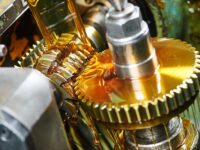Eurofins TestOil offers a number of tests that detect and measure wear metals. Two that are generally included in routine analysis are Elemental Spectroscopy and Ferrous Wear Concentration. We also offer Analytical Ferrography and, as a component of Filter Debris Analysis, we conduct EDXRF (energy dispersive x-ray fluorescence) on samples mainly composed of solids.
Eurofins TestOil’s Matt McMahon, Oil Analyst III Field Technician, explains the details of each Wear Metals test.
- Elemental Spectroscopy: This is capable of detecting 21 different elements including those associated with wear such as iron, copper, lead, aluminum, tin, nickel, chromium, titanium, vanadium, and silver.
- Ferrous Wear Concentration: This measures the amount of iron found in wear debris with no upper size limit of individual particles.
- Analytical Ferrography: This is primarily used to observe the size and shape of wear debris found in the oil sample. The test visually examines wear debris via microscopy
- Filter Debris Analysis Our XRF instrument is capable of detecting 25 different elements including ones associated with wear such as aluminum, antimony, cadmium, chromium, copper, iron, lead, nickel, silver, tin, tungsten, and vanadium.
Matt advises that these tests are important because they give an indication of the mechanical health of the machine. “A wear element that appears that wasn’t previously detected in prior samples may be an indication of an abnormal wear mode,” he says. “Additionally, a sudden increase in the rate of generation of wear elements can indicate mechanical issues. Generally, you want to keep your lubricant in good condition before it potentially starts having an effect on machine health. However, for those marginal lubricants, an unusual increase in wear metals indicates that action needs to be taken with regards to fixing the lubricant condition before a possible mechanical failure occurs.
Among the value adds Eurofins TestOil offers that most of our competitors do not is complementary testing and this applies to Wear Metals testing as well.
Matt explains, “When wear metals are in alarm by either Elemental Spectroscopy or Ferrous Wear Concentration, for our industrial samples, we automatically add Analytical Microscopy at no additional charge, to examine the size and quantity of wear particles. Often the analysts will revise the overall machine condition based on what is observed.”
Even though Elemental Spectroscopy and Ferrous Wear Debris tests are routine, in many cases it’s best to run them together. “There is a size limit with regards to what the elemental spectrometer can measure,” Matt observes. “So, for instance, you wouldn’t want to rely solely on Elemental Spectroscopy to detect large particles that may be generated in a machine such as a gearbox. For this type of machine, we often recommend a test package that includes both Elemental Spectroscopy and Ferrous Wear Debris. When you have both of these tests, you can generally infer the size of the iron particles present in the sample.”
He adds, if the Elemental Spectroscopy iron result is high and Ferrous Wear Debris low, that typically means the iron particles are small in size (and considered “normal” wear particles). On the other hand, if the Elemental Spectroscopy results are low and Ferrous Wear Debris is high, that generally means the iron-containing particles are large in size and may need immediate action to determine the cause of the large-sized wear particle distribution.
This blog post is the first in a series on the 3 categories of oil tests. In addition to Wear Metals, the other 2 are:
- Oil Condition testing reveals the health of the lubricating oil itself. We determine if the lubricant is still fit for use and the extent of degradation that may have occurred.
- Contaminant Detection testing helps our analysts identify foreign contaminants that may have entered the lubricating system.
For more information on working with Eurofins TestOil for oil analysis and training visit www.testoil.com. Contact: 216-251-2510; sales@testoil.com.
About Eurofins TestOil
With more than 30 years of experience in the oil analysis industry, Eurofins TestOil focuses exclusively on assisting industrial facilities with reducing maintenance costs and avoiding unexpected downtime through oil and fuel analysis program implementation. As industry experts in diagnosing oil-related issues in equipment such as turbines, hydraulics, gearboxes, pumps, compressors and diesel generators, Eurofins TestOil provides customers with same-day turnaround on routine oil analysis testing. For more information on partnering with Eurofins TestOil on oil analysis programs or training opportunities visit https://testoil.com. Contact: Michael Barrett 216-251-2510; sales@testoil.com.
About Eurofins – the global leader in bio-analysis
Eurofins is Testing for Life. Eurofins is the global leader in food, environment, pharmaceutical and cosmetic product testing, and in discovery pharmacology, forensics, advanced material sciences and agroscience Contract Research services. Eurofins is also a market leader in certain testing and laboratory services for genomics, and in the support of clinical studies, as well as in BioPharma Contract Development and Manufacturing. The Group also has a rapidly developing presence in highly specialised and molecular clinical diagnostic testing and in-vitro diagnostic products.
With over 61,000 staff across a network of 940 laboratories in 59 countries, Eurofins’ companies offer a portfolio of over 200,000 analytical methods. Eurofins Shares are listed on Euronext Paris Stock Exchange.


